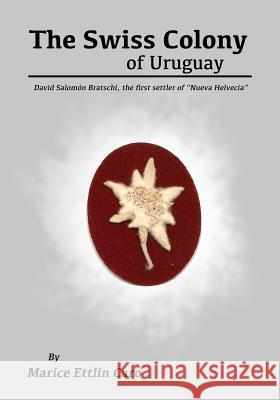The Swiss Colony of Uruguay: David Salomón Bratschi, the first settler of Nueva Helvecia » książka
The Swiss Colony of Uruguay: David Salomón Bratschi, the first settler of Nueva Helvecia
ISBN-13: 9780692593189 / Angielski / Miękka / 2015 / 106 str.
The changes brought by the Industrial Revolution of the nineteenth century forced many Europeans to travel to the Americas looking for a better future for their families and new business ventures. Among them were two Swiss individuals from the Canton of Bern, Carlos Augusto Cunier and David Solomon Bratschi. They came together in 1858 to the future Swiss colony of "Nueva Helvecia" in the state of Colonia in Uruguay. Cunier a businessman, purchased farmland from the "Sociedad ArgrIcola del Rosario Oriental" to resale to Swiss settlers that began arriving in 1861. Bratschi an immigrant, settled with his family in the land allocated for agricultural settlers, thus becoming the first Swiss settler who came three years before the rest of the Swiss immigrants. The new immigration law of Uruguay of 1853 welcomed European settlers offering ten years free taxation, and total autonomy as long as the Uruguayan laws were respected. At first the Swiss settlers were not integrated into the local society, they were not integrated into their own community as well. They continue observing the religious separatist ideas brought from the old country. These conflicts were evident in "Nueva Helvecia" for nearly a century; it is only after the Second World War that the doors open to a full integration between Catholics and Protestants, and between "Criollos" and "Gringos." David Salomon Bratschi had three families because of the early death of his first two wives. He had a total of therteen children, eleven born in Uruguay and two in Argentina. Out of the therteen children, eleven settled in Argentina and two in Uruguay. All the Bratschis born in Uruguay and Argentina descended from David Solomon Bratschi, as it is demonstrated in this genealogical research.
The changes brought by the Industrial Revolution of the nineteenth century forced many Europeans to travel to the Americas looking for a better future for their families and new business ventures. Among them were two Swiss individuals from the Canton of Bern, Carlos Augusto Cunier and David Solomon Bratschi. They came together in 1858 to the future Swiss colony of "Nueva Helvecia" in the state of Colonia in Uruguay. Cunier a businessman, purchased farmland from the "Sociedad Argrícola del Rosario Oriental" to resale to Swiss settlers that began arriving in 1861. Bratschi an immigrant, settled with his family in the land allocated for agricultural settlers, thus becoming the first Swiss settler who came three years before the rest of the Swiss immigrants. The new immigration law of Uruguay of 1853 welcomed European settlers offering ten years free taxation, and total autonomy as long as the Uruguayan laws were respected. At first the Swiss settlers were not integrated into the local society, they were not integrated into their own community as well. They continue observing the religious separatist ideas brought from the old country. These conflicts were evident in "Nueva Helvecia" for nearly a century; it is only after the Second World War that the doors open to a full integration between Catholics and Protestants, and between "Criollos" and "Gringos". David Salomon Bratschi had three families because of the early death of his first two wives. He had a total of therteen children, eleven born in Uruguay and two in Argentina. Out of the therteen children, eleven settled in Argentina and two in Uruguay. All the Bratschis born in Uruguay and Argentina descended from David Solomon Bratschi, as it is demonstrated in this genealogical research.











